Props to Earl Hays
Are you familiar with The Earl Hays Press? They have perhaps been the biggest purveyors of “fake news” for more than 100 years—and we don’t mean that in a negative way. Founded in 1915 and based in Southern California, it has been the print shop that provided prop newspapers for virtually all Hollywood productions ever since. And not just newspapers; any printed prop, from currency, to bottle labels, to license plates, to books, to passports, to Victor Laszlo’s transit papers—you name it—has likely been designed and printed by The Earl Hays Press. Earl Hays himself started as a dressmaker, but also owned a printing press, and happened to be friends with Harry Warner, one of the Warner brothers, before Warner Brothers as a studio existed. Hays realized early on that the nascent motion picture industry was going to need printed materials—props, dialogue cards for silent movies, etc.—and set himself up to produce them. And the press has been doing it ever since, although since 2000 other providers have been entering the market.
In this very cool Tested video, Adam Savage talks with Michael Corrie, who has been archiving all of Hollywood’s printed props and shows off some highlights of the press’ work over the years.
If you’re a fan of printing and old movies, you’ll want to check it out. And then go watch Casablanca.
Drum Keys
We can’t help but feel that the late great Neil Peart would have loved this. Via Laughing Squid, musician Eric Carr built a typewriter out of drums, each drumhead sporting a different letter of the alphabet.
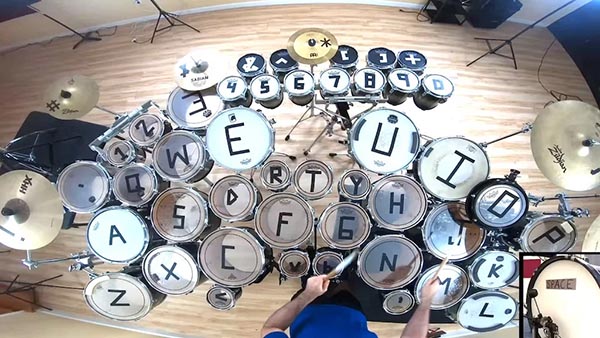
He can then drum individual words.
“Subscribe” was the 2nd hardest word to play. The 1st hardest was “supercalifragilisticexpialidocious.”
ZIP It
Some of you may have vague recollections of when the US Postal Service introduced ZIP codes. We take them for granted today, but at the time, they revolutionized mail delivery. Short for “Zone Improvement Plan,” it was first conceived by postal inspector Robert Moon in 1944, although the idea languished for a couple of decades before it was implemented in 1963. (A limited postal code system was adopted for a few large cities during the Second World War—experienced mail clerks were off fighting in the war, so large cities were divided into numbered zones to help the fill-ins, who may not be familiar with individual postal routes, sort the mail efficiently.) (By the way, and we’re not making this up, Moon—living up to his name, perhaps, or the space-race euphoria of the 1960s—also left behind a ZIP code scheme for interplanetary mail. So if we ever colonize the Moon, look for direct mail printers to adopt Every Crater Direct Mail.)
Anyway, the advent of the ZIP code was a big deal back in the 60s, and, via Laughing Squid, a folk band called the Swingin’ Six were recruited for a Schoolhouse Rock-esque musical PSA that aired in 1967 explaining the importance of the ZIP code.
Groovy.
Comic Con
Mercifully, the use of Comic Sans has seemed to have ebbed (perhaps font-shaming has had a positive effect, or maybe we just don’t even notice it anymore), but via Boing Boing, Japanese designer Toshi Omagari has created a variant called Comic Code which is intended for programming. There is a method to his madness:
Comic Code is a monospaced adaptation of the most infamous yet most popular casual font. Designed specifically for programming as the name suggests, which is a corner of typography that involves intensive typing that feels more akin to handwriting than typesetting, this typeface took inspirations from friendly characteristics and low-resolution legibility of Comic Sans. It is an unapologetic admittance of Comic Sans’s positives, and a literal manifestation of “code like nobody's watching.”
He also addressed some of Comic Sans’ flaws.
poor outline and spacing qualities stick out to me, which I addressed in Comic Code while respecting the same design intention. While others may have issues with the fundamental concept itself, I see it as a positive. Let’s face it; sometimes, professional appearance is exactly what you don’t want. Comic Sans resonates because it doesn’t talk down to you while making its message clearly heard with legible letters (not saying Comic Code is illegible tho). It is my wish to make codes look less intimidating to humans, including those with dyslexia.
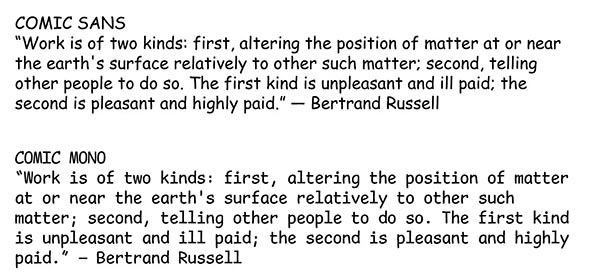
Fair point.
Eraser Head
Now, granted, in this day and age, few of us do manual writing and drawing any longer, but there are still those who do drafting using pencil and paper. And when doing that kind of work, erasing errors can become an issue, which is why many draftspeople or artists use eraser shields, so that they can run an eraser over a narrow bit of a drawing without removing something correct and important. However, via Core77, a more elegant solution is the Milikeshi Rubber Eraser by Japanese stationery manufacturer Kokuyo:
The Kokuyo Milikeshi is an innovative eraser with 5 edge sizes in one implement! Using just one eraser you can choose from erasing with a sharp corner, a 3 mm edge, a 4 mm edge, a 5 mm edge, or a 6 mm edge! The Milikeshi was designed by visual designer, Mr. Yuji Baba, Professor Emeritus of Tohoku University of Art and Design.
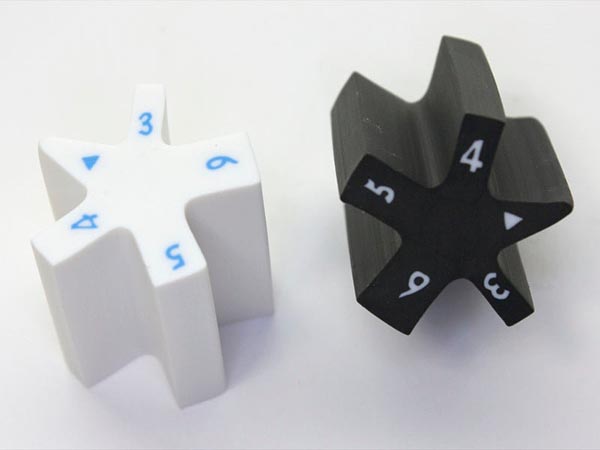
You could probably also use them as dice in Dungeons & Dragons.
Shapes of State
Here’s an idea for a world tour: visit, in order, the world’s most rectangular countries. Then, as a follow-up, visit the world’s roundest countries. If you were a geo-statistician, that might be a grand tour that sounds really appealing.
Geopolitical borders are rarely drawn with aesthetics or geometry in mind, but over at Atlas Obscura, Australian geo-statistician David Barry developed “dataset that minutely describes the borders of all countries on Earth and devise[d] an algorithm that compares each country’s shape to an optimum rectangle with the same area,” which sounds exactly like what a geo-statistician would do. His conclusion? Egypt is the world’s most rectangular country. And Argentinian mathematician Gonzalo Ciruelos determined that Sierra Leone is the world’s roundest country.
As the winners in both categories indicate, Africa is a continent of great diversity in geopolitical morphology. But the most curious country in either ranking is … the Vatican. As it turns out, the Papal State is both the fourth roundest and the second most rectangular country in the world. How is that possible?
In the rectangular category, Barry’s “optimum rectangularity” is “the maximum percentage overlap of a country with a rectangle of the same area.” Still, some countries defy such categories as “round” or “rectangular.”
He’s the first to admit that his algorithm may be inadequate for some countries with complex shapes (“Italy looks like the biggest country that might be wrong”), scattered geographies (e.g. Norway, because it includes Bouvet Island, a Norwegian dependency located between South Africa and Antarctica, freakishly far from the motherland), or locations on either side of the 180° longitude meridian (New Zealand, United States, Russia).
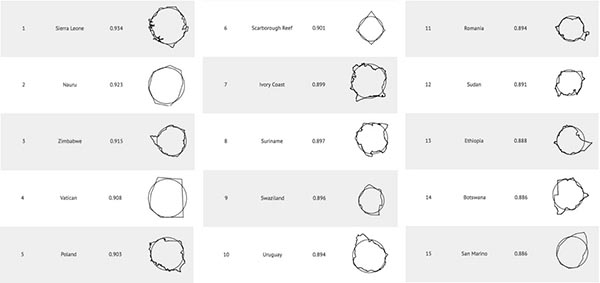
Ciruelos’s roundest countries.(Gonzalo Ciruelos)
So what does this teach us about geography?
Little of any practical value, except this: The fact that the Vatican scores pretty high on both lists has nothing to do with divine intervention. Contrary to common sense, countries can be both very rotund and very rectangular at the same time.
Methodologies and maps can be found on Ciruelos’s web page and Barry’s page.
By the way, if you are interested in the implications of geopolitical borders, we highly recommend David Fromkin’s book A Peace to End All Peace: The Fall of the Ottoman Empire and the Creation of the Modern Middle East.
Great White Lines
It’s been a while (well, three years) since we had a quintessential “2020 headline,” but this week The Guardian had one: “Experts say ‘cocaine sharks’ may be feasting on drugs dumped off Florida.” Sounds like a bad Jaws/Scarface mashup (but better than Sharknado). “Cocaine Sharks” is part of The Discovery Channel’s upcoming “Shark Week,” although it seems like every week is Shark Week on The Discovery Channel. Scientific American takes up the story—sharks off the coast of Florida, a major drug-smuggling route, can potentially come into contact with large amounts of narcotics.
“This is the only place in the world where a shark could come into contact with such massive doses of cocaine,” says Tom Hird, a marine biologist and broadcaster based in England.
…Hird thinks the chance of sharks encountering the drug is much higher than it is for most other predators—including bears. “I fully believe that it’s real, especially with the amount of cocaine that is washing up” in Florida, Hird says. “And that's just the stuff that makes it to the beach. It doesn’t include the stuff that gets caught out at sea.” Because cocaine is soluble in water, he says, a shark swimming in the vicinity of a damaged package could theoretically get a contact high.
(The title is meant to pay homage to Cocaine Bear, a recent film based on a 1985 incident in which a black bear went on a cocaine-fueled rampage in Georgia.)
So the phrase “great white” may become a slang term for cocaine.
Turning the Tide (Pen)
Sometimes it’s the simple things in life that get us jazzed. To wit: via The Verge, WD-40 is now available in a Tide Pen-like format. No more mucking about with bulky spray cans or those butterfly-proboscis-like tubes, allowing you to apply lubricant with more precision.
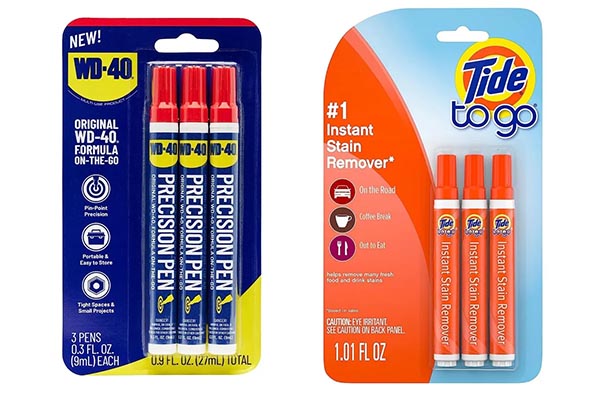
Pick up a three-pack on Amazon for $12.75. You’re welcome.
Turning the Stomach
Speaking of Tide, remember back in 2018 when eating Tide Pods was a thing (a bad thing, but a thing nonetheless)? Well, now there is now a new TikTok (what else?)-based thing that involves consuming or bathing in borax. Wha? Says Ars Technica:
In the latest health fad to alarm and exasperate medical experts, people on TikTok have cheerily “hopped on the borax train” and are drinking and soaking in the toxic cleaning product based on false claims that it can reduce inflammation, treat arthritis, and “detoxify” the body.
We don’t know that it’s a train; probably more like a 20-mule team. But anyway, Borax is mostly found in laundry detergents, and poison control centers are now on alert.
Meanwhile, the borax trend has hit the radar of poison control centers and toxicology experts. In a debunking article from the National Capital Poison Center, the organization outlined a case of one man who had to go to the emergency department days after soaking in a borax bath, which caused severe skin irritation, swelling, and dryness.
And that's not the worst of it. According to the National Institute of Health's Office of Dietary Supplements, ingesting borax or the related boric acid can cause nausea, gastrointestinal discomfort, vomiting, diarrhea, skin flushing, rash, excitation, convulsions, depression, and vascular collapse.
The magic ingredient is apparently boron.
Some of the TikTokers advocating for drinking or bathing in borax note that it contains boron, which is a naturally occurring trace element readily found in common foods, such as fruits, peanuts, legumes, potatoes, and milk. It’s (of course) also found in dietary supplements. But, boron is not considered an essential nutrient for humans, and researchers have not identified a clear biological function for the element.
Plutonium is a naturally occurring element, but we would not advocate having anything to do with it.
At any rate, if you have teens and you find the laundry detergent has gone missing, it might be time to have a word.
Graphene Clears the Air
Was it a good week for graphene news? It’s always a good week for graphene news! Graphene-based air filtration devices. From (who else?) Graphene-Info:
Directa Plus recently announced winning a project tender by the Lombardy Region in Italy, as part of its research and innovation program, to further develop its Graphene Plus air filtration applications.
…Directa said the award would allow it to continue investing and developing its air filter applications. The company has been working on the development of Graphene Plus air filters since 2020, after commercializing the Co-Mask in the fight against Covid-19.
Carbon Voyage
Earlier this week, Cary Sherburne wrote about some of the initiatives for reducing carbon. One of those initiatives, albeit a controversial one, is carbon capture. Interestingly, in the news this week, via Semafor:
ExxonMobil staked out its vision for its transition to a lower-carbon business model when it spent $4.9 billion to acquire Denbury, a smaller Texas oil and gas company with the U.S.’s largest network of pipelines designed to carry carbon dioxide. The acquisition signals the momentum growing behind “carbon management” as an enterprise that fits better with the traditional strengths of oil and gas companies than renewable energy.
Said Tim O’Donnell, Semafor editor:
Exxon’s vision is that eventually these pipelines will ferry CO2 captured from industrial point sources like cement and steel plants, and potentially from natural gas power plants, and transport it to underground rock formations or old oil wells where it could be buried (Denbury also owns a number of large sites for carbon sequestration).
Companies that want to use CCS to lower their carbon footprint could turn to Exxon as a one-stop carbon disposal shop. Exxon is already building up a portfolio of this kind of business, signing several carbon management deals in the last year with chemical and steel companies. The Denbury acquisition will allow the company to “accelerate the growth of this business and do that on a very profitable basis,” Dan Ammann, president of Exxon’s low carbon solutions division, told Bloomberg.
Scalability has been a major issue for carbon capture, but companies of ExxonMobil’s size can help overcome that problem.
Crunch Time
Ah, 1963. It was an event-filled year. As we saw earlier, not only was the ZIP code introduced, but it also saw the introduction of Cap’n Crunch, who has graced many of our childhood (and, to be honest, adult) breakfast tables. However, there has always been something a bit off about the Cap’n—aside from his levitating eyebrows or that he hasn’t had a promotion in 60 years, despite his decades of service keeping the Soggies at bay—which, via Food & Wine, is finally being addressed: the gold stripes on his sleeves don’t reflect his rank.
Cap’n Crunch has been wearing a coat sporting three bars — reserved for the lower rank of commander — instead of the four bars befitting of a captain. In fact, since the character was first created in 1963 by television producer Allan Burns (who also worked on Rocky and Bullwinkle and co-created The Munsters and The Mary Tyler Moore Show, among other credits), Cap’n Crunch’s sleeves have varied from depicting him as an ensign (one bar) to lieutenant (two bars), and, presently, commander.
…But for the Cap’n’s 60th birthday, the folks at The Quaker Oats Company decided it was time to set things right. Starting this month, Cap’n Crunch’s uniform is getting a long overdue adjustment on all of the brand’s cereal and snack products.
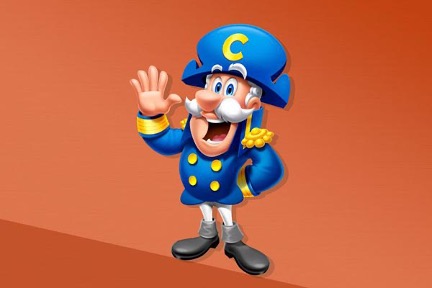
We expect nothing but accuracy in our breakfast cereal mascots.
And it is good to know that by the 31st century he’ll have been promoted to Admiral (and Count Chocula has become an Archduke).
This Week in Printing, Publishing, and Media History
July 24
1847: Richard March Hoe patents the rotary-type printing press.
1895: English poet, novelist, and critic Robert Graves (I, Claudius and Claudius the God) born.
1900: Zelda Fitzgerald, American author, poet, and wife/drinking buddy of F. Scott Fitzgerald born.
1901: Author O. Henry is released from prison in Columbus, Ohio, after serving three years for embezzlement from a bank. The ending was not a surprise.
1969 : Apollo 11 splashes down safely in the Pacific Ocean.
July 25
1834: English philosopher, poet, and critic Samuel Taylor Coleridge dies (b. 1772).
1837: The first commercial use of an electrical telegraph is successfully demonstrated in London by William Cooke and Charles Wheatstone.
1965: Judas! Bob Dylan goes electric at the Newport Folk Festival.
1976: Viking 1 takes the famous Face on Mars photo.
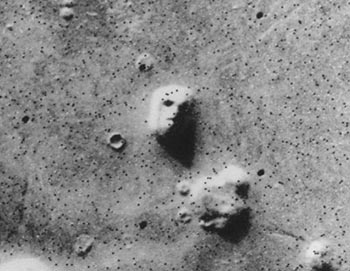
July 26
1502: German printer Christian Egenolff born.
1856: Irish playwright, critic, and Nobel Prize laureate George Bernard Shaw, born.
1887: Publication of the Unua Libro, founding the Esperanto movement.
1894: English novelist and philosopher Aldous Huxley born.
1928: American director, producer, screenwriter, and cinematographer Stanley Kubrick born.
1989: A federal grand jury indicts Cornell University student Robert T. Morris, Jr. for releasing the Morris worm, thus becoming the first person to be prosecuted under the 1986 Computer Fraud and Abuse Act.
July 27
1866: The first permanent transatlantic telegraph cable is successfully completed, stretching from Valentia Island, Ireland, to Heart’s Content, Newfoundland. They could now communicate with each other to their heart’s content.
1940: What’s up, Doc? The animated short A Wild Hare is released, introducing the character of Bugs Bunny.
1938: Gary Gygax, creator of Dungeons & Dragons, born.
July 28
1844: English poet Gerard Manley Hopkins born.
1866: At the age of 18, Vinnie Ream becomes the first and youngest female artist to receive a commission from the United States government for a statue (of Abraham Lincoln).
July 29
1805: French historian and philosopher Alexis de Tocqueville born.
1818: French physicist Augustin Fresnel submits his prizewinning “Memoir on the Diffraction of Light,” precisely accounting for the limited extent to which light spreads into shadows, and thereby demolishing the oldest objection to the wave theory of light.
1953: Canadian musician Geddy Lee (né Gary Lee Weinrib) born.
1958: U.S. President Dwight D. Eisenhower signs into law the National Aeronautics and Space Act, which creates the National Aeronautics and Space Administration (NASA).
July 30
Both English novelist and poet Emily Brontë (1818) and English singer-songwriter and producer Kate Bush (1958) born.
1909: English historian and author C. Northcote Parkinson, coiner of “Parkinson’s Law,” born. He would soon grow to fill the entirety of his crib.
1932: Premiere of Walt Disney’s Flowers and Trees, the first cartoon short to use Technicolor and the first Academy Award-winning cartoon short.
2006: The world’s longest running music show Top of the Pops is broadcast for the last time on BBC Two. The show had aired for 42 years.















Discussion
Only verified members can comment.